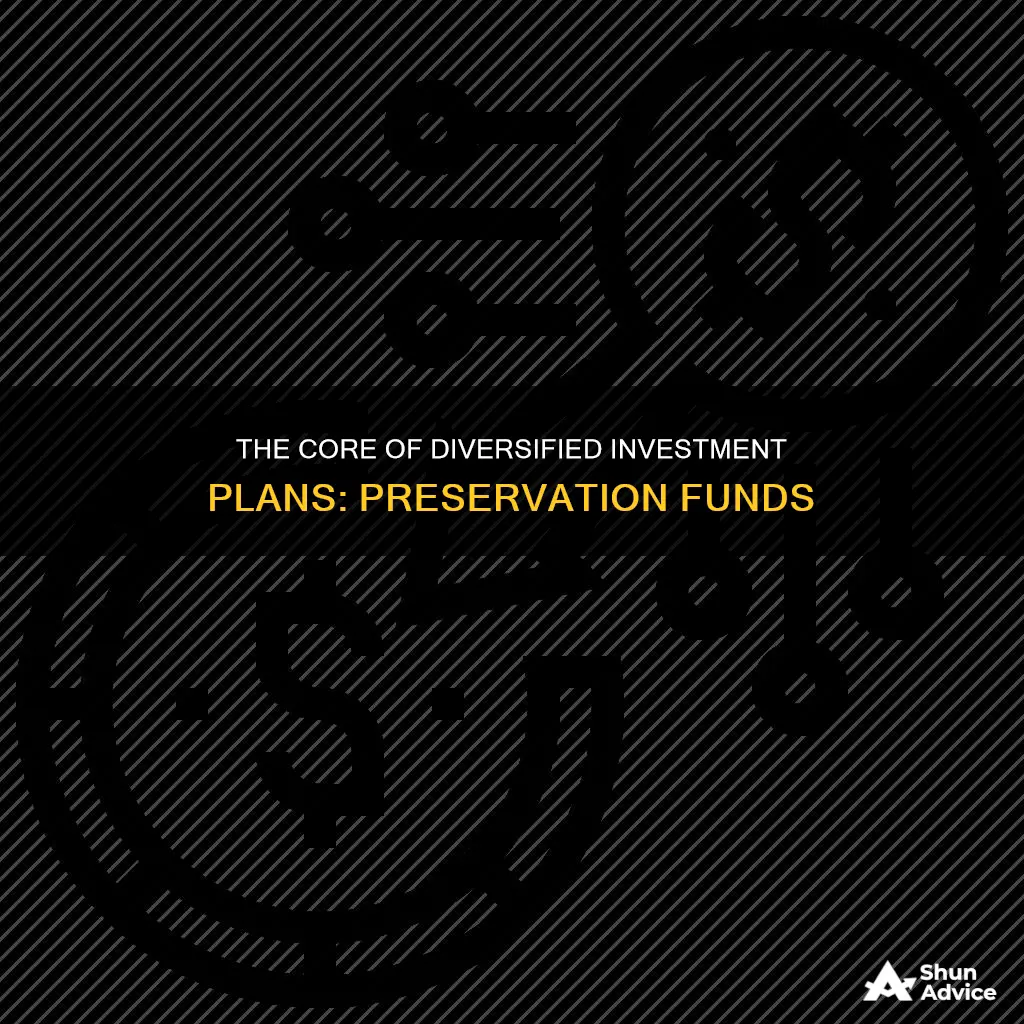
The foundation of a diversified investment plan is a portfolio that balances risk and reward by spreading investments across multiple assets. This strategy, known as diversification, helps to reduce the volatility of a portfolio over time and can lead to growth while preserving capital. For example, a portfolio might include a mix of stocks, bonds, real estate, and other asset classes. A diversified fund can be actively managed or passively tracked to an index, and it may focus on a particular area or sector. When investing in funds, individuals benefit from the expertise of a professional fund manager and gain access to a wider range of investments, such as overseas shares or commodities.

Capital preservation funds
One example of a capital preservation fund is the Principal Guaranteed Option (PGO), which provides a compelling credit rate over a full interest rate cycle. It is accessible, flexible, and portable, allowing investors to stay in the investment option even if their plan transitions to a new record-keeper. The PGO is a fixed-income product that preserves capital while aiming to keep pace with current market interest rates.
Another option is the Principal Fixed Income Guaranteed Option (PFIGO), a conservative foundation for retirement programs. This investment is a guaranteed general account-backed group annuity contract issued by Principal Life Insurance Company. The value of the PFIGO does not fluctuate with the stock and bond markets, providing stability and security to investors concerned about market volatility. Additionally, the interest rate is declared in advance, so investors know what interest will be earned.
For those seeking a one-fund investment, a target-date fund offers an easy way to achieve diversification, capital preservation, and modest appreciation for a low fee. These funds automatically rebalance and are professionally managed to become more conservative as the target retirement date approaches. For instance, the Vanguard Target Retirement 2025 Fund (VTTVX) is designed for individuals expecting to retire in approximately three to seven years, with a mix of stocks and bonds.
A Secure Guide to Insurance Fund Investment
You may want to see also

Real estate investments
Capital Preservation
Capital preservation is a critical aspect of investing in real estate. It focuses on maintaining the monetary value of an asset and preventing losses in an investment portfolio. Real estate is generally considered a safe investment option for capital preservation as property prices tend to grow with inflation, providing returns that are less prone to fluctuations compared to equities and bonds. Core real estate properties, which are stable income-generating assets, are often favoured for their lower risk.
Diversification Strategies
To further reduce risk, investors can diversify their real estate investments across different geographical markets and property types, such as residential or commercial properties. This diversification can also be achieved through investment vehicles like Real Estate Investment Trusts (REITs), syndicated investments, and portfolios of Delaware Statutory Trust (DST) investments. These options allow investors to access a variety of properties and spread their risk.
Risk Management
Access to Expertise
Investing in real estate funds provides access to professional expertise. Fund managers conduct thorough research and possess extensive knowledge, allowing investors to benefit from their insights and experience. This is particularly advantageous for those who are new to investing or who do not have the time or resources to devote to full-time stock picking.
Global Opportunities
Real estate funds offer access to a wide range of global investment opportunities, including overseas markets, property, and commodities like oil or gold. This provides investors with a broader spectrum of options to diversify their portfolios.
Suitability
While real estate investments offer numerous benefits, it is important to remember that they may not be suitable for everyone. It is essential to assess your own risk tolerance, investment goals, and time horizon before deciding to invest in real estate. Additionally, real estate investments may require certain income and net worth levels, so it is important to carefully review the requirements of each investment opportunity.
Energy Mutual Funds: Invest Now or Wait?
You may want to see also

Stocks
When investing in stocks, it is important to consider the time horizon and risk tolerance. For instance, a younger investor with a longer time horizon may be willing to take on more risk in pursuit of higher returns, whereas an older investor may opt for more conservative investments to protect their savings from market volatility.
To mitigate the risks associated with stocks, investors can consider investing in a diversified fund, which holds a broad array of securities across multiple sectors and geographic regions. This helps to prevent events in one area from significantly affecting the entire portfolio. Additionally, investors can opt for funds that are actively managed by professionals, who can leverage their expertise and research to make investment decisions.
For those seeking a more conservative investment strategy, capital preservation-focused investment options are available, such as guaranteed investment options, stable value investment options, and principal guaranteed options. These options prioritise preserving capital over aggressive growth, offering a compelling credit rate over a full interest rate cycle.
In summary, stocks play a significant role in diversified investment plans, particularly for those seeking higher growth. However, due to their volatile nature, it is important to carefully consider one's risk tolerance and time horizon before investing in stocks and to balance stock investments with less risky alternatives.
Venture Capital Funds: A Guide to Getting Started
You may want to see also

Bonds
When considering bonds for your investment plan preservation fund, it is essential to understand the different types of bonds available. Bonds can be categorised based on their maturity, credit quality, and coupon rate. Here are some common types of bonds:
- Corporate bonds: These are issued by corporations to fund their operations and are typically considered higher-risk investments than government bonds.
- Government bonds: Issued by governments to finance public projects and are generally considered low-risk investments. Examples include US Treasuries and UK Gilts.
- Municipal bonds: Offered by state and local governments or their subsidiaries to fund public projects. They often provide tax benefits and are considered relatively low-risk.
- Mortgage-backed securities: These bonds are backed by a collection of mortgages and can include both residential and commercial properties.
- Asset-backed securities: This type of bond is backed by assets other than mortgages, such as student loans, auto loans, or credit card debt.
When investing in bonds, it is important to consider the credit quality of the issuer. Bonds are given credit ratings by agencies such as Moody's or Standard & Poor's, which indicate the likelihood of the issuer defaulting on their payments. Higher-rated bonds are considered safer investments but typically offer lower interest rates. Lower-rated bonds, also known as "high-yield" or "junk" bonds, offer higher interest rates but carry a higher risk of default.
Another factor to consider when investing in bonds is the coupon rate, which represents the interest paid by the issuer to the bondholder. Bonds with higher coupon rates provide higher periodic payments but may be more sensitive to changes in interest rates.
When constructing a diversified investment plan preservation fund, it is essential to combine bonds with other asset classes, such as stocks, commodities, and real estate. This diversification helps to further reduce risk and smooth out the ups and downs of the market. Additionally, investing in a mix of bond types with different maturities and coupon rates can provide a more stable foundation for long-term investment success.
SBI Debt Fund: A Smart Investment Strategy
You may want to see also

Money market funds
There are several types of money market funds, including:
- Government MMFs: These invest at least 99.5% of their assets in cash, government securities, or repurchase agreements that are collateralized by government securities.
- Short-term credit (Prime) MMFs: These can invest in government securities and securities issued by banks, corporations, and other non-government entities.
- Municipal MMFs: These buy municipal bonds and other debt securities, offering potential tax benefits to investors as earnings are typically exempt from federal and sometimes state income tax.
- Standard MMFs: These have a minimum investment horizon of three months and offer the opportunity for yield uplift by holding less liquidity, longer duration, and slightly lower credit quality.
Bond Index Funds: Safe Investment Havens?
You may want to see also
Frequently asked questions
A diversified fund is an investment fund that is spread across multiple market sectors, assets, and/or geographic regions. It holds a breadth of securities, often in multiple asset classes, to prevent events in one area from affecting an entire portfolio.
Diversified funds are a great foundation for a portfolio as they offer instant diversification. They are managed by professionals, so you benefit from their expertise and research. They are also a good way to reduce risk and volatility in your portfolio.
Some examples of diversified funds include index funds, actively managed funds, and balanced funds. Index funds track the performance of a particular market index, while actively managed funds aim to outperform an index and are more expensive. Balanced funds typically contain a mix of stocks and bonds, such as 70% stocks and 30% bonds.
A diversified portfolio can include stocks, bonds, short-term investments, international stocks, sector funds, commodity-focused funds, and real estate funds. Stocks provide higher growth over the long term but carry more risk, while bonds offer regular interest income and are less volatile.
When choosing a diversified fund, consider your risk tolerance, time horizon, and investment goals. Review the fund's objectives, strategies, and investment types to ensure they align with your own goals and risk profile. Also, consider whether you want the fund to be actively or passively managed.







